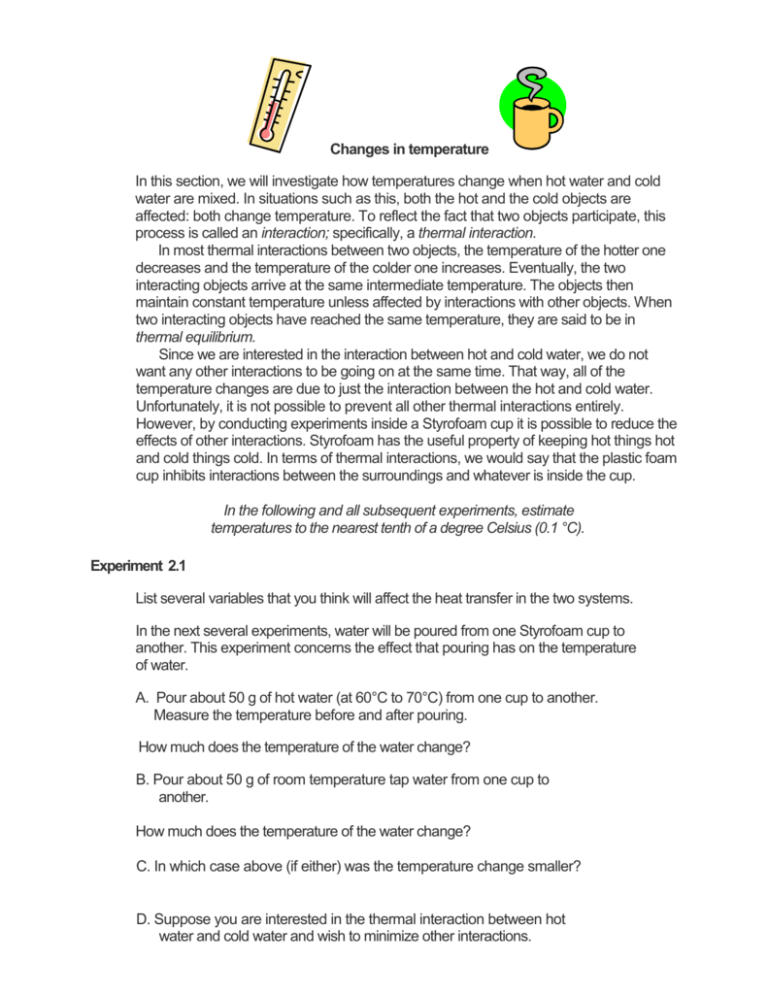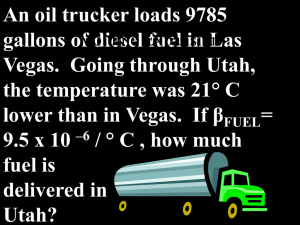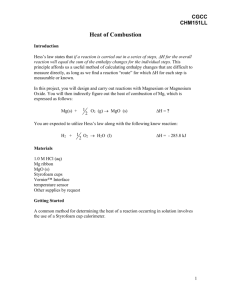Changes in temperature
advertisement

Changes in temperature In this section, we will investigate how temperatures change when hot water and cold water are mixed. In situations such as this, both the hot and the cold objects are affected: both change temperature. To reflect the fact that two objects participate, this process is called an interaction; specifically, a thermal interaction. In most thermal interactions between two objects, the temperature of the hotter one decreases and the temperature of the colder one increases. Eventually, the two interacting objects arrive at the same intermediate temperature. The objects then maintain constant temperature unless affected by interactions with other objects. When two interacting objects have reached the same temperature, they are said to be in thermal equilibrium. Since we are interested in the interaction between hot and cold water, we do not want any other interactions to be going on at the same time. That way, all of the temperature changes are due to just the interaction between the hot and cold water. Unfortunately, it is not possible to prevent all other thermal interactions entirely. However, by conducting experiments inside a Styrofoam cup it is possible to reduce the effects of other interactions. Styrofoam has the useful property of keeping hot things hot and cold things cold. In terms of thermal interactions, we would say that the plastic foam cup inhibits interactions between the surroundings and whatever is inside the cup. In the following and all subsequent experiments, estimate temperatures to the nearest tenth of a degree Celsius (0.1 °C). Experiment 2.1 List several variables that you think will affect the heat transfer in the two systems. In the next several experiments, water will be poured from one Styrofoam cup to another. This experiment concerns the effect that pouring has on the temperature of water. A. Pour about 50 g of hot water (at 60°C to 70°C) from one cup to another. Measure the temperature before and after pouring. How much does the temperature of the water change? B. Pour about 50 g of room temperature tap water from one cup to another. How much does the temperature of the water change? C. In which case above (if either) was the temperature change smaller? D. Suppose you are interested in the thermal interaction between hot water and cold water and wish to minimize other interactions. What does your answer to part C suggest about whether it is better to pour hot water into cold water or cold water into hot water? Explain. It is important in the following experiments to know the temperatures of the two samples of water immediately before they are mixed. The following procedure for mixing the water should be followed. Procedure for mixing water samples Record the temperature of the tap water first, since its temperature will not be changing while it is in the cup. Hold the cup of tap water above the hot water as if you were about to pour the first drop. Just before you actually do pour, record the temperature of the hot water. Then immediately pour the room temperature water into the hot water. Quickly record the temperature of the resulting mixture. Experiment 2.2 A. Mix equal masses of hot water and tap water. Use at least 25 g of water for each sample. Carefully note the temperature of each sample before mixing and then note the final temperature after mixing. Use several initial temperatures for the hot water, but do not use temperatures higher than 60°C or the water will cool too fast in the cup. Continue experimenting until you have a rule for predicting the temperature of the mixture and data to support your rule. Write a clear statement of your rule. B. When hot and cold water are mixed, the hot water cools off and the cold water warms up. The final temperature of both is the same. If we subtract the final temperature from the initial temperature of the cold water, the answer will tell us how much the temperature of the cold water changed. We can similarly calculate the temperature change of the hot water. Calculate the temperature changes of the hot water and of the cold water in each of your experiments in part A. How do the temperature changes of the hot and cold water compare? Experiment 2.3 In this experiment, we will investigate how the masses of the samples of water affect the final temperature of the mixture. A. Mix various amounts of hot and room temperature water. Use at least 25 g of water for each sample. Do not use water hotter than 60°C. Use simple mass ratios such as 2 to 1, 1 to 2, 3 to 1, 2 to 3, and so on. Do four experiments. B. Enter your results in a table like the one below: Mass Hot Water Cold Water Initial Final Temp. Mass Initial Final Temp. Temp. Temp. Change Temp. Temp. Change C. If two samples of water are mixed, it is possible to predict which sample will change temperature more. How? Support your answer with data from part A. D. For each experiment in part A, calculate the following two quantities: Quantity 1: the mass of the hot water times the temperature change of the hot water. Quantity 2: the mass of the cold water times the temperature change of the cold water. Plot a graph of quantity 1 versus quantity 2. That is, plot a graph of the mass times temperature change for the hot water versus the mass times temperature change for the cold water. Should (0,0) be included as a data point? E. The graph of quantity 1 versus quantity 2 should be nearly straight. Draw a single straight line through the middle of the points. Note: When experimental data points do not lie exactly in a neat pattern, the usual practice is to draw a smooth curve or line through the points. Do not draw a connect-the-dots, zigzag line. Such a line implies that you think the measured data points are exact, with no uncertainty. A zigzag graph indicates that the quantities are related in a very irregular way; a smooth graph indicates a more regular relation. Compute the slope of the graph. What does your result for the slope imply about the relation between the mass times temperature change of the hot water and the mass times temperature change of the cold water? What does your data suggest about interpreting the statement “Heat loss = Heat gained?” Consider different ways of defining the system.







